Social Anxiety Disorder/Social Phobia
Table of Contents
What is a Social Anxiety Disorder?
Social Anxiety Disorder (also called Social Phobia) is when certain social or performance situations (e.g., meeting new people or giving a speech) are avoided due to substantial fear of being judged or embarrassed in front of other people.
When exposed to a social situation, someone with Social Anxiety Disorder is so afraid of being negatively evaluated or judged that it significantly interferes with his or her ability to live a normal life. This can cause him or her to avoid everyday social situations, like going shopping, speaking up in class, using a public bathroom, or participating in gym class.
SIGNS & SYMPTOMS:
Feelings of shyness or discomfort in certain situations aren’t necessarily signs of social anxiety disorder, particularly in children. Comfort levels in social situations vary, depending on personality traits and life experiences. Some people are naturally reserved and others are more outgoing.
In contrast to everyday nervousness, social anxiety disorder includes fear, anxiety, and avoidance that interfere with daily routine, work, school, or other activities. Social anxiety disorder typically begins in the early to mid-teens, though it can sometimes start in younger children or in adults.
Emotional and behavioral symptoms
Signs and symptoms of social anxiety disorder can include persistent:
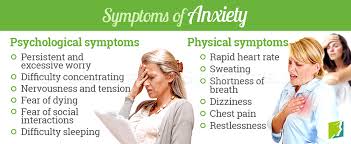
1 Fear of situations in which you may be judged
2 Worrying about embarrassing or humiliating yourself
3 Intense fear of interacting or talking with strangers
4 Fear that others will notice that you look anxious
5 Fear of physical symptoms that may cause you embarrassment, such as blushing, sweating, trembling, or having a shaky voice
6 Avoiding doing things or speaking to people out of fear of embarrassment
7 Avoiding situations where you might be the center of attention
8 Having anxiety in anticipation of a feared activity or event
9 Enduring a social situation with intense fear or anxiety
10 Spending time after a social situation analyzing your performance and identifying flaws in your interactions
11 Expecting the worst possible consequences from a negative experience during a social situation
For children, anxiety about interacting with adults or peers may be shown by crying, having temper tantrums, clinging to parents, or refusing to speak in social situations.
Physical symptoms:
a) Blushing
b) Fast heartbeat
c) Trembling
d) Sweating
e) Upset stomach or nausea
f) Trouble catching your breath
g) Dizziness or lightheadedness
h) Feeling that your mind has gone blank
i) Muscle tension
j) Abdominal pain
k) Avoiding eye contact
l) Weepin, tantrum, clinging to parents, or isolation in children
m) Clammy & cold hands
n) Crying
o) Dry mouth & throat
Avoiding common social situations:
Common, everyday experiences that may be hard to endure when you have social anxiety disorder include, for example:
- Interacting with unfamiliar people or strangers
- Attending parties or social gatherings
- Going to work or school
- Starting conversations
- Making eye contact
- Dating
- Entering a room in which people are already seated
- Returning items to a store
- Eating in front of others
- Using a public restroom
Causes of Social Anxiety Disorder
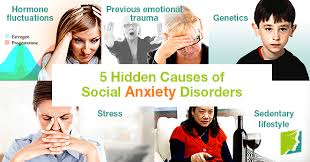
Experts say that social anxiety disorder has both environmental and genetic causes.
Genetic causes: As the condition appears to run in families, genetic links are being investigated. There is ongoing research that attempts to find out how much of this is genetic and how much is acquired.
Chemicals in the body: Scientists are currently researching which chemicals in the body might promote the development of social anxiety disorder. Serotonin, a brain chemical, may play a key role when levels are not right or if an individual is extremely sensitive.
Brain structure: Some researchers believe the amygdala in the brain may play a role in fear response, resulting in excessive reactions.
Weather and demographics: Mediterranean countries have lower rates of social anxiety disorder compared to Scandinavian countries. This could be due to warmer weather as well as a higher population density.
Traumatic events: Sexual or physical abuse may trigger the condition.
Treatment of Social Anxiety Disorder
Social anxiety disorder is a treatable condition, and various therapeutic approaches, including cognitive-behavioral therapy (CBT), medication, and mindfulness-based interventions, have been shown to be effective in helping individuals manage symptoms and improve their ability to engage in social interactions.
Early recognition and intervention are crucial in addressing social anxiety disorder and preventing long-term complications.
Psychotherapy Treatment
Cognitive behavioral therapy (CBT)
Medical Treatment
Serotonin reuptake inhibitors (SSRIS)
Benzodiazepines
Betablockers
Physiotherapy Treatment
Anxiety disorders are serious mental conditions that can affect your thoughts and behavior negatively. It’s crucial to deal with them effectively.

There are different types of anxiety disorder such as specific phobia, generalized anxiety disorder, adult separation anxiety disorder, panic disorder, and social anxiety disorder. Among the symptoms of anxiety disorders are a feeling of fear, sleep problems, dry mouth, fast heart rate, nausea, and dizziness.
There is no denying the fact that exercise can have a tremendous impact on both your physical and mental well-being. And since physical therapists also focus on treating their patients by improving their physical fitness with different types of exercise it can surely treat patients suffering from anxiety disorders. In other words, Physiotherapy treatment can easily improve the mental health of a person suffering from anxiety.
Here is how physical therapy can help people struggling with anxiety:
- Improve Your Fitness
- Reduce Stress
- Elevate Mood
- Lowers Blood Pressure

1] Recognize symptom onset:
Your best and first line of defense when dealing with any form of social anxiety is listening to your mind and body. Become tuned in to how your body is responding to the environment you are in and with the people around you. The moment you start to feel the onset of your anxious symptoms is the moment you need to take responsible actions to keep your own well-being in check.
Physiological responses to anxiety include blushing, sweating, racing heart, shaking, difficulty breathing or shortness of breath, feeling light-headed or faint and dizzy, dry mouth, and sometimes stuttering.
You may be thinking to yourself, “Everyone is staring at me. What are they thinking? Are they judging me?” “They probably think I am a loser. I need to get out of here, I don’t fit in or belong here.” “I don’t know what to say. I don’t have anything to contribute to the conversation. They will see that I am nervous. I will be the fool.”
Behavioral responses to anxiety may include avoidance, leaving situations or events early, only arriving at a situation or event with a companion or friend you feel comfortable with by your side, increased focus on your phone, being overly apologetic, seeking reassurance from others, and obsessiveness with watching responses of others towards you.
2] Exercise where you are:
If you’re experiencing anxiety at the moment, find a way to exercise where you are. You might be in your office or at class when you start to feel anxious. Wherever you are, you can do exercises to help you with your social anxiety.
Excuse yourself and take a few moments by yourself to do some jumping jacks.
Take a brisk walk up and down a couple flights of stairs.
If you have a private space, do some exercises where you are such as pushups, situps, or balancing exercises.
3] Go for a quick walk:
If you feel anxious and want to move, taking a walk can be a great option. Take a walk around your home, office, or school building, or outside. Passing anxiety can be reduced with just 10 minutes of exercise. If you’re nervous about a meeting at work or a presentation in front of many people, clear your mind and decrease your anxiety beforehand with a pleasant walk.
If weather permits, go outside and take a walk. Being in nature can be calming and soothing.
4] Do aerobic exercise:
If you have a situation in the immediate future that’s making you anxious, squeeze in some time beforehand to exercise. Aerobic exercises (such as running, swimming, biking, or rollerblading) can be helpful in reducing anxiety and stress. Especially if stress has affected your ability to concentrate, exercise can improve your focus and alertness. Just five minutes of aerobic exercise can start.
Exercise can even protect you from stress, anxiety, and depression. People who exercise regularly are less likely to develop symptoms of depression or anxiety.
5] Practice relaxation:
Along with exercise, relaxation can play a major role in addressing your social anxiety. Try progressive muscle relaxation to calm your body and your mind. Relaxation can help you lower stress, reduce anxiety, and help you stabilize your moods. Find 30 minutes each day to practice something relaxing.

For example, try qi gong and meditation. You can also take a bath, write in a journal, or read.
6] Combine exercise with therapy:
People who exercise and complete cognitive-behavior therapy for anxiety tend to see larger gains in their treatment. if you’re already taking medications or seeing a therapist for your social anxiety, consider adding exercise to your treatment and see how it affects you.
Always choose an exercise program that appeals to you. Most of all, stick with it to see the best results.
7] Set fitness goals:
If you feel nervous around other people or of public performance, you might struggle with feeling confident in yourself. Your confidence may affect your job performance, considerations for a promotion, or your aspirations in life. Exercising can help you build physical and mental skills. You can create and meet goals and overcome negative thoughts that might contribute to your social anxiety.
Push yourself to try something new or set a fitness goal. For example, do 20 push-ups, run a mile, or bench press 40 pounds. Meeting your goals can help you feel more confident and increase positive feelings about your abilities.
8] Exercise with others:
If you struggle with isolation, make a point to be with others in a small environment. For example, join a small gym or a running club. If being in a group sounds too intimidating, ask someone to be your workout buddy. Go to the gym together or keep each other accountable for your weekly exercise. If you struggle to motivate yourself to exercise or work out, having some accountability can greatly improve your chances of moving.

Ask a close friend or family member to join a gym together.
Use exercise classes as a way to meet people and build friendships. For example, set a goal to say hello to someone new or talk to someone after class.
9] Go outside:
If the idea of going to a gym seems sweaty, stinky, expensive, or unenjoyable, opt to exercise outside. Go for a jog around your local park, take a hike, or go rock climbing. Start by exercising on your own or joining a small group. Being outside can expose you to nature and give you vitamin D, which can help with mood.
Take your dog on a walk or grab your kids and take a walk in the park together.

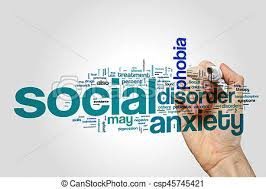

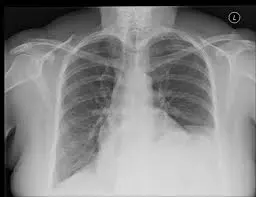
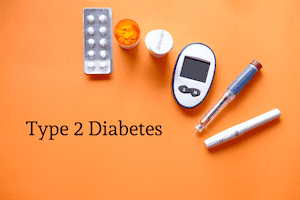

One Comment